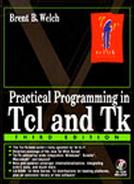Chapter 1. Tcl Fundamentals
This chapter describes the basic syntax rules for the Tcl scripting language. It describes the basic mechanisms used by the Tcl interpreter: substitution and grouping. It touches lightly on the following Tcl commands: puts, format, set, expr, string, while, incr, and proc.
Tcl is a string-based command language. The language has only a few fundamental constructs and relatively little syntax, which makes it easy to learn. The Tcl syntax is meant to be simple. Tcl is designed to be a glue that assembles software building blocks into applications. A simpler glue makes the job easier. In addition, Tcl is interpreted when the application runs. The interpreter makes it easy to build and refine your application in an interactive manner. A great way to learn Tcl is to try out commands interactively. If you are not sure how to run Tcl on your system, see Chapter 2 for instructions for starting Tcl on UNIX, Windows, and Macintosh systems.
This chapter takes you through the basics of the Tcl language syntax. Even if you are an expert programmer, it is worth taking the time to read these few pages to make sure you understand the fundamentals of Tcl. The basic mechanisms are all related to strings and string substitutions, so it is fairly easy to visualize what is going on in the interpreter. The model is a little different from some other programming languages with which you may already be familiar, so it is worth making sure you understand the basic concepts.
